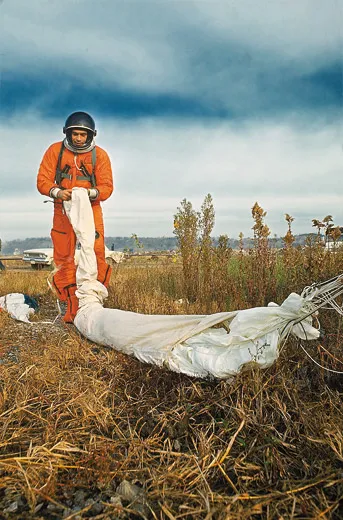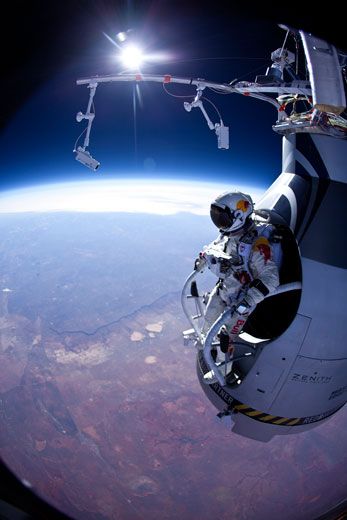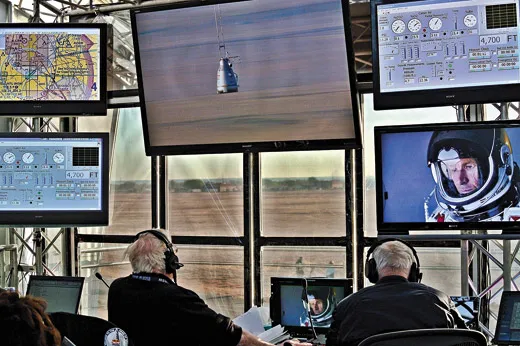The 120,000-Foot Leap
Can space-diver Felix Baumgartner break the sound barrier without breaking his neck?
/https://tf-cmsv2-smithsonianmag-media.s3.amazonaws.com/filer/Bullet-Man-Felix-Baumgartner-FLASH.jpg)
Update: Baumgartner hopes to make his jump on Sunday, October 14. Check here for the latest news.
ON THE MORNING OF March 15, 2012, Felix Baumgartner scooted forward, stood up, and grabbed the handrails on either side of the door he’d just opened. From where he was standing, he could see all of New Mexico and parts of Texas, Arizona, and Colorado. He was 71,581 feet —13 and a half miles—above Earth, dangling in a small capsule from a balloon the size of a 16-story building. Facing the cameras mounted on the capsule, he gave a little salute, a bit awkward in his full-pressure spacesuit, and stepped off.
After freefalling for three and a half minutes and reaching a top speed of 364 mph, the Austrian skydiver pulled open his chute and glided safely to the ground. Back at the airstrip where the balloon had launched, near Roswell, New Mexico, the Red Bull Stratos project team at mission control erupted into cheers.
This was only a test jump. Sometime early this summer, Baumgartner will try from 90,000 feet. Then, later in the summer, he’ll jump from more than 120,000 feet, setting, he hopes, a number of world records.
Always ready to sponsor the latest extreme sport, energy-drink maker Red Bull is footing the bill for what began as a personal dream for Baumgartner. An accomplished BASE jumper (someone who parachutes off of Buildings, Antennas, Spans—bridges—and Earth—cliffs), he set his sights in 2005 on breaking the world record for highest skydive. Since then, Red Bull has helped Baumgartner assemble a world-class team of experts, and has paid for the gear and ground support to get him up to 23 miles and back.
One of the first people to congratulate him upon his return to Earth was retired Air Force Colonel Joe Kittinger, one of only two other people to have survived a skydive from more than 70,000 feet, and the current record holder (102,800 feet). He’s the Stratos Capcom, or capsule communicator, and he’ll be the voice Baumgartner hears as he makes his balloon ascent.
“Felix is a very fortunate man, just like I was,” says Kittinger. “Freefall for five and a half minutes—that is the absolute fantasy of every skydiver.”
When Kittinger, who early in his Air Force career was a test pilot, set the record back in 1960, it was under slightly different circumstances. The Space Race had just begun, and the U.S. government was in a hurry to find out how humans could survive beyond Earth’s atmosphere. First came a series of manned balloon tests called Project Manhigh, in which human guinea pigs, including Kittinger, climbed into the stratosphere to experience the kind of environment astronauts would face.
At the same time, jet aircraft like the new U-2 spyplane were reaching altitudes of up to 70,000 feet, and the Air Force wanted to know whether pilots could survive a bailout in a near-vacuum. To find out, Kittinger came up with Project Excelsior—a fancy-sounding name for riding in a tiny basket to the edge of space, wearing only the standard partial-pressure suit given to all high-altitude pilots, and jumping out.
Unlike Baumgartner, Kittinger wasn’t an accomplished skydiver—the big jump was only his 33rd. He wanted to prove that any high-altitude pilot could survive a bailout using only standard-issue equipment, plus one important addition: Kittinger’s team designed an automatic, multi-stage parachute system that included a special drogue—a small stabilizing chute—to protect him from a deadly flat spin, one of the many dangers of a long freefall.
Aerodynamic forces can set a falling body spinning at up to 240 rotations per minute. That’s the equivalent of 37 Gs, enough to knock you unconscious almost instantly. A flat spin can be fatal, and once it gets going, it’s impossible to correct with body posture alone—like trying to lift a ton of bricks while passing out. The drogue system developed for Excelsior is now used in all aircraft ejection seats.
Kittinger’s record has gone mostly unchallenged for half a century. In 1962, Soviet Army parachutists Eugene Andreev and Peter Dolgov jumped from beneath a balloon after floating well into the stratosphere. Dolgov’s pressure suit was breached, exposing him to the near-vacuum outside, and by the time his automatic parachute deposited him on the ground, he was dead. Andreev, though, still holds the record for longest freefall without the assistance of a drogue chute: 80,380 feet.
The only other serious challenger was a truck driver from New Jersey. Nick Piantanida, a daredevil who dabbled in exotic animal dealing, decided after his very first skydive in 1963 that he would try to break Kittinger’s record. With very little parachuting experience and even less technical knowledge, he set about raising money and finding experts who could show him the way.
Piantanida was able to accomplish an astonishing amount, given that he started with no ties to the U.S. military or NASA. While the record is unofficial, there is no doubt he went higher than any other human has in a balloon—123,500 feet. Preparing to jump on his second attempt at the record, Piantanida discovered that the coupling connecting his suit to the oxygen supply in his gondola was frozen solid and he couldn’t disconnect it. He was stuck, and his team had no choice but to cut the gondola free and return him to the ground under its parachute.
Baumgartner is unlikely to be undone by such simple mishaps. Kittinger says comparing his own open-air gondola (and Piantanida’s, which was similar) to Baumgartner’s pressurized capsule is like comparing a Model T Ford to a Ferrari. But it’s not just the equipment that sets Baumgartner apart from other aspiring high-divers. His main asset is his team.
“They’re taking advantage of this historical expertise,” says Craig Ryan, a historian of manned balloon flights and author of books about both Kittinger and Piantanida. “When Kittinger did it,” he says, “there wasn’t any historical expertise.”
According to Ryan, the Project Excelsior team made it up as they went along. At one point an engineer tied Kittinger’s helmet on with nylon clasps to keep it from popping off under low pressure at altitude. To monitor his heartbeat, his physicians taped an analog microphone to his chest.
Baumgartner has it a little better. “Basically we want to instrument Felix just like he was an airplane,” says Jon Clark, a former NASA space shuttle crew surgeon and Stratos’ medical director. Baumgartner will be wearing a physiological monitoring system used by the U.S. military and adapted for the Stratos project. The instrument pack, worn on the jumper’s chest, will monitor his heart and respiratory rates and collect echocardiogram data. It also has an accelerometer, which will monitor whether Baumgartner’s body is spinning and if so, how fast. If he’s experiencing more than 3.5 Gs of rotational force, his stabilizing drogue chute will deploy automatically.
“We are doing stuff that’s been done before, if only by a few people,” says Clark. “But what we’re doing is capturing more information.”
Baumgartner’s team says that its primary aim is to advance the science of survival at extreme altitude, not just to break records or publicize Red Bull. One contribution they expect to be useful to future pilots and astronauts is a new field treatment protocol for vacuum exposure. Called high-frequency percussive ventilation (HFV), the technique would help a victim of vacuum exposure breathe without further damage to the lungs. While the treatment is common practice for burn victims, no one has ever thought to use it on victims of sudden decompression.
The threat of exposure to near-zero atmospheric pressure levels is one of Clark’s biggest worries. If Baumgartner’s suit fails, the fluids in his body will start to boil and bubble in a process called ebullism. The resulting tissue damage could kill him if not treated immediately, so Clark is determined to have an HFV machine on the ground in case something goes wrong.
There are other concerns. At some point during his descent, Baumgartner will experience temperatures as low as –148 degrees Fahrenheit, factoring in the wind chill. For the 71,500-foot test jump, he opted not to have electric warmers installed in his gloves and boots because they decreased mobility. Afterward, he reported that his hands had been so cold he could hardly move them. “He was surprised, but we weren’t,” says Kittinger, a bit smugly. He had suspected the wind chill would make Baumgartner feel colder than he had in pressure chamber tests. “I bet he won’t do it again.”
The greatest danger to Baumgartner is a flat spin, but he hopes not to have to use the drogue chute so he can break Andreev’s record. He proved on the test jump that he can use skills he has developed over years of skydiving—slightly changing the position of his limbs to control his attitude—to prevent spinning. Stratos engineers have made Baumgartner’s suit as flexible as possible to improve his ability to make those fine adjustments.
Stratos has arranged for the Fédération Aéronautique Internationale, the world body governing aeronautics records, to be watching when Baumgartner makes his attempt from 120,000 feet. Red Bull wants to make sure the jump counts. If he’s successful, Baumgartner won’t just set the record for highest skydive. He’ll also try to set records for longest freefall and highest manned balloon flight, and may become the first person to break the sound barrier without the aid of a vehicle.
Yes, that’s possible. Because the air is so much thinner in the stratosphere, the speed known as terminal velocity—the point at which air friction cancels out gravitational acceleration—is much higher there than it is near the ground. The Stratos team reckons Felix will reach at least 690 mph, somewhere near the 105,000-foot mark. Adjusting for altitude and temperature, that should be just fast enough to break the sound barrier.
According to the Stratos team, as a shock wave builds up on his helmet, Baumgartner might feel a little vibration near his head. Then, as he reaches and surpasses the speed of sound, the sensation will move instantly to his feet and disappear until he slows and goes subsonic again, at which point he might feel another vibration. That’s if everything goes well.
What happens if things don’t go well is the only genuine mystery in this venture. Fifty-two years ago, Kittinger showed that a stratospheric jump was possible, and there should be no real surprises about the leap itself. But no one has ever crossed the sound barrier quite this way before. There’s one possibility in particular that interests Clark, something called shock-shock interaction.
When a fighter goes supersonic, separate shock waves originate from the nose of the airplane and from its other surfaces. If the shock waves intersect, they intensify enough to generate heat. A supersonic aircraft has to be designed to divert those shock waves away from one another, otherwise the heat and force of the interaction could damage or even destroy the airplane.
In theory, something similar could happen to Baumgartner when he reaches Mach 1, as shock waves bounce off of differently angled parts of his body. Clark’s thinking, though, is that because the air up there will be very thin, the shock waves will be weak. And by gradually easing across the threshold, Baumgartner will prevent any serious danger of shock-shock interaction. So for Clark, it’s more a matter of curiosity than real worry.
Clark has a personal reason for working to make Baumgartner, and future astronauts, safer. His wife, Laurel Clark, was one of the crew members lost in the 2003 Columbia accident. But unlike the space shuttle, which broke up going 13,000 mph, Baumgartner will be falling in a stable position at a comfortable Mach 1. The Stratos team suspects he might not notice when he hits the speed of sound.
In fact, during the first few seconds after he jumps from his capsule above 120,000 feet, he won’t even feel like he’s falling. Air resistance will be so minimal that it will seem like he’s simply floating above Earth. As he gains speed and hits denser atmosphere, wind blast forces will kick in and Baumgartner will be on his home skydiving turf, pulling the chute at around 5,000 feet, where there’s enough air for it to fully deploy. By then, it will feel much like a typical skydive, except it will have lasted longer and the view will have been better.
In may 1966, Three months after his failed second try, Nick Piantanida took one more shot at breaking Kittinger’s record. The oxygen hose disconnection problem had been resolved, and he considered the third attempt to be a shoe-in. On May 1, he lounged near his gondola awaiting takeoff, then kissed his wife before closing his helmet visor and sealing his suit. He climbed into the gondola while the balloon filled, then took off. Things went smoothly until he reached around 57,000 feet. At that point, roughly an hour into his flight, Piantanida’s team heard a whooshing sound over the radio. They asked him to respond, but he could only get out part of the word “emergency.”
By the time the team got him back on the ground, Piantanida had suffered massive tissue damage due to ebullism, and he was barely conscious. At the hospital he slipped into a coma. Four months later, he died. According to Ryan, all evidence points not to an equipment failure, but to a human one.
“Piantanida’s flaw was his refusal to set up an organizational structure, to have anybody there who had the power to tell him ‘You can’t go,’ ” says Ryan. Kittinger, who refused to join Piantanida’s team for that reason, though he had been asked several times, says that Piantanida wouldn’t have died if he’d had a Jon Clark on his team. Clark would have seen him walking around without his helmet sealed only minutes before takeoff, and would have aborted the flight then and there, since Piantanida was supposed to be breathing pure oxygen for at least an hour before the flight to prevent decompression sickness.
That breach in protocol wasn’t what killed him, though. Piantanida had a bad habit of opening his helmet visor, and the evidence suggests that he did this at 57,000 feet, perhaps to clear condensation, and couldn’t get the visor closed again. It was a mistake he had been warned about many times.
There have been a few would-be record setters since then, but none has come close to getting off the ground. Ryan says that none of them has had Red Bull’s money, or the expertise and discipline of Kittinger, Clark, and the rest of the Stratos team.
“Not all of us can or even want to do this stuff,” Ryan says. “I think that’s why we all sit here and watch, holding our breath, hoping these guys make it.”
That’s another thing that has changed since the 1960s. Baumgartner’s leap will be captured by nine high-definition cameras, including three strapped to his body. Whatever happens, we’ll all be able to watch, holding our breath, as it’s webcast live.
Mark Betancourt is a writer and filmmaker living in Washington, D.C.


